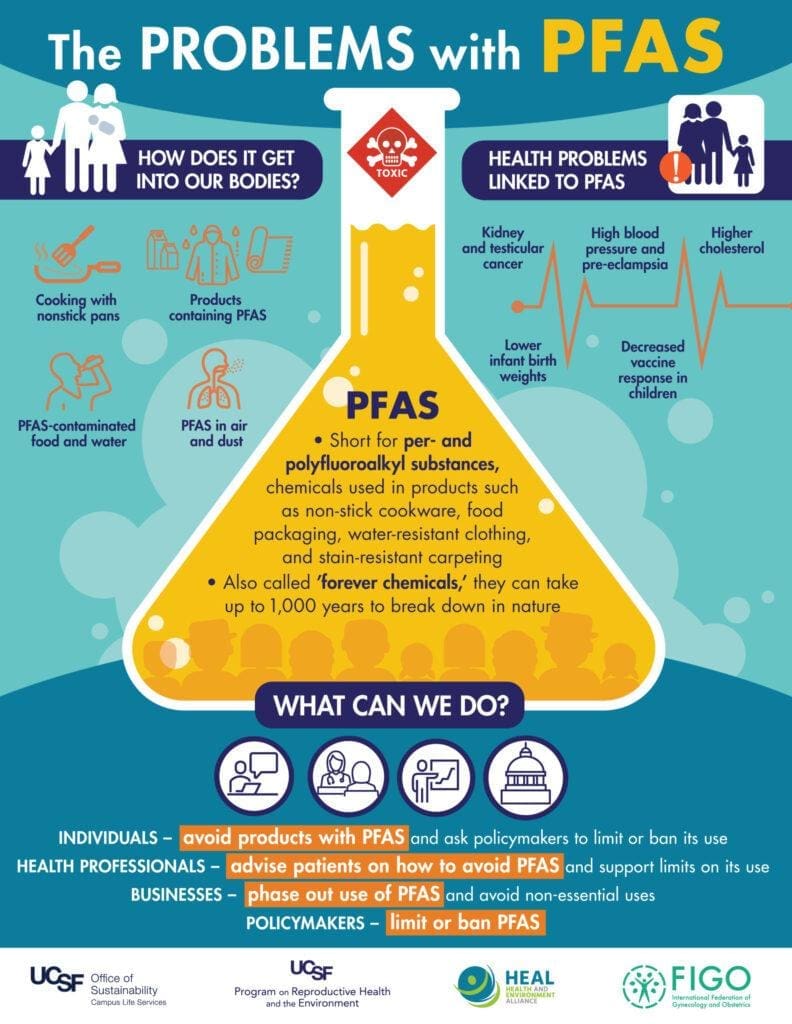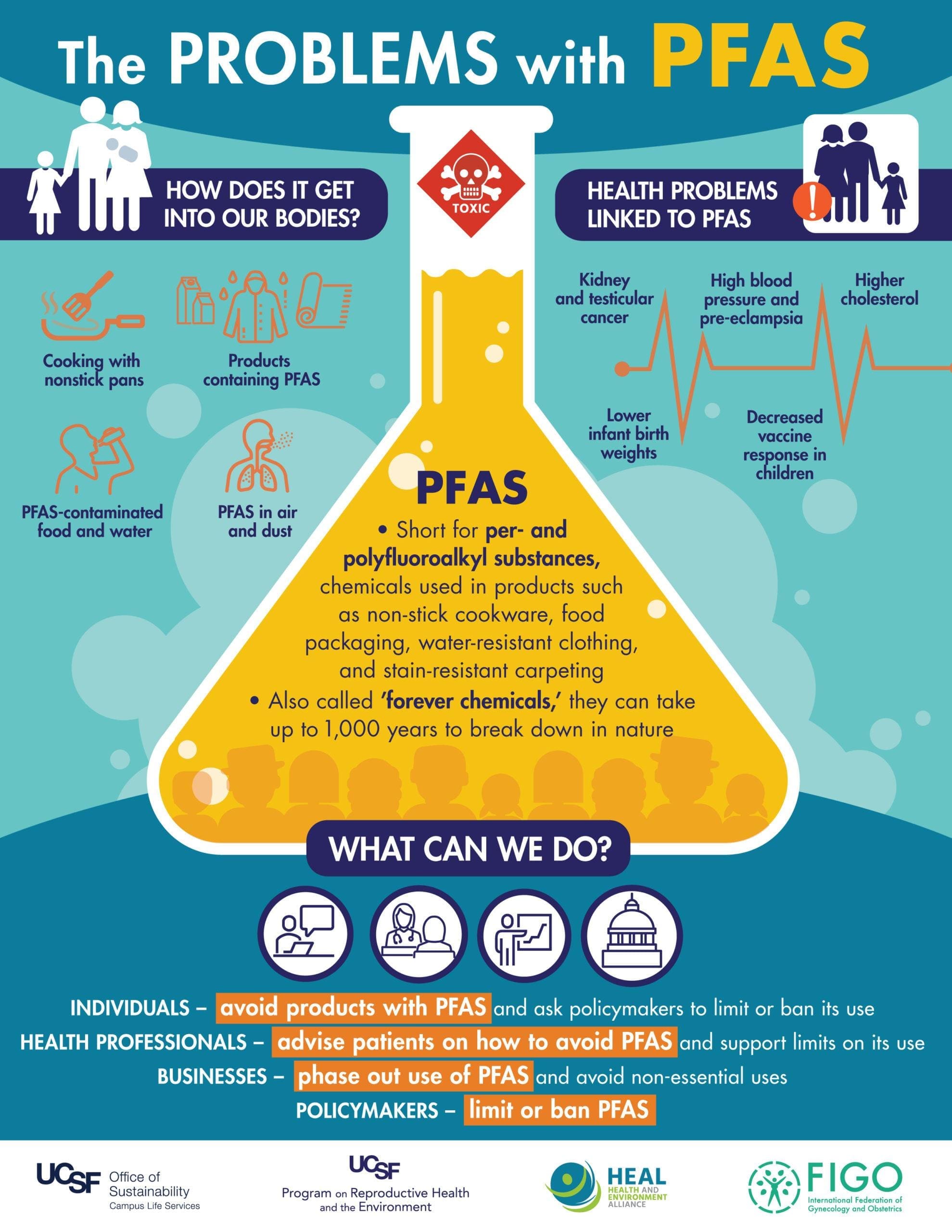Posted by : ZeroRisk Cases Marketing
Overview Of PFAS And Their Environmental Impact
Per- and polyfluoroalkyl substances (PFAS) are a group of synthetic chemicals that have been widely used in various industrial and consumer products since the 1940s. Known for their resistance to water, oil, and heat, PFAS are commonly found in non-stick cookware, waterproof clothing, firefighting foams, and food packaging. Despite their utility, PFAS have garnered significant attention due to their persistence in the environment and potential adverse health effects.
PFAS are often called “forever chemicals” because they do not break down easily under natural conditions. This persistence leads to bioaccumulation in wildlife and humans over time. Studies have linked exposure to certain PFAS with a range of health issues, including liver damage, thyroid disease, decreased fertility, increased cholesterol levels, obesity, hormone suppression, and cancer.

From an environmental standpoint, PFAS contamination is particularly concerning due to its widespread distribution. These chemicals can leach into soil and groundwater from industrial sites or landfills where PFAS-containing products are disposed of. Once released into the environment, they can travel long distances via water currents or atmospheric deposits. This has resulted in detectable levels of PFAS in remote locations far from any direct source of pollution.
The ubiquity and resilience of PFAS pose significant challenges for environmental remediation efforts. Traditional water treatment methods often do not remove these substances from contaminated sites. As research continues into effective mitigation strategies and alternatives to PFAS-laden products become more prevalent, understanding the full scope of their environmental impact remains crucial for policymakers and public health officials alike.
Recent Legal Developments In PFAS Litigation
Recent legal developments in PFAS litigation continue to shape the landscape of environmental law and corporate accountability. As of September 2024, there have been several significant strides in both state and federal courts regarding the regulation and responsibility associated with per- and polyfluoroalkyl substances (PFAS), often referred to as “forever chemicals” due to their persistence in the environment and human body.
One notable development is the increasing number of lawsuits filed by state attorneys general against major chemical manufacturers. These cases typically allege that companies knowingly produced and distributed PFAS compounds while concealing their harmful environmental and health effects. Recent settlements have seen substantial financial penalties imposed on these corporations, often directed toward remediation and public health initiatives.
Federal legislation has also seen momentum, with new amendments proposed to strengthen the Toxic Substances Control Act (TSCA) specifically targeting PFAS chemicals. These legislative efforts aim to expedite the process of listing PFAS as hazardous substances under the Comprehensive Environmental Response, Compensation, and Liability Act (CERCLA), commonly known as Superfund law. If successful, this could significantly impact ongoing litigation by establishing a clearer framework for liability.
In addition to governmental action, class action lawsuits by affected communities are gaining traction. Residents from areas with contaminated water supplies increasingly seek compensation for health issues linked to PFAS exposure. Courts have started recognizing these claims more frequently, setting important precedents that could influence future litigation outcomes.
These developments underscore a growing recognition of the need for stringent regulation and accountability concerning PFAS contamination, reflecting broader societal demands for environmental justice and corporate responsibility.
Key Cases And Settlements In 2024
In September 2024, several key cases and settlements marked significant developments in PFAS (per- and polyfluoroalkyl substances) litigation, reflecting the ongoing complexities and evolving legal landscape surrounding these persistent environmental contaminants. One of the most notable cases involved a major chemical manufacturer, which reached a substantial settlement with multiple states over allegations of widespread PFAS contamination. This settlement, which included monetary compensation and commitments to fund extensive environmental remediation projects, underscored the growing accountability imposed on corporations for their historical use of these chemicals.
Another critical case this year centered on a class-action lawsuit filed by affected communities against several prominent companies. The plaintiffs argued that prolonged exposure to PFAS had led to serious health issues, including cancer and thyroid disease. In response to mounting evidence presented during the trial, one company opted for an out-of-court settlement that included financial reparations and agreements to implement more stringent safety measures in their manufacturing processes.
Additionally, a landmark ruling favored plaintiffs who sued a major water utility company for failing to filter out PFAS from drinking water supplies adequately. The court’s decision mandated immediate upgrades to filtration systems and set a precedent for future public utilities litigation.
These pivotal cases illustrate the intensifying scrutiny of PFAS-related activities and signal significant strides toward holding polluters accountable while ensuring better protection for public health and the environment. They also highlight the increasing willingness of courts to impose stringent remedies to mitigate ongoing contamination issues.
Regulatory Changes Affecting PFAS Litigation
In September 2024, several significant regulatory changes notably influenced the landscape of PFAS (per—and Polyfluoroalkyl Substances) litigation. These modifications have shaped the legal strategies employed by plaintiffs and defendants and impacted the overall direction and intensity of ongoing and future cases.
One key regulatory shift came with the Environmental Protection Agency’s (EPA) updated guidelines on PFAS levels permissible in drinking water. The new, more stringent limits reflect growing concerns about the adverse health effects linked to PFAS exposure, such as cancer, liver damage, and immune system disorders. This heightened regulatory scrutiny has provided plaintiffs with more substantial grounds for claims against manufacturers and users of PFAS, arguing that non-compliance or negligence has led to widespread contamination.
Moreover, recent amendments to state-level regulations have introduced mandatory reporting requirements for businesses that manufacture or use PFAS compounds. These changes facilitate greater transparency and accountability, allowing communities affected by contamination to trace sources more efficiently. Consequently, these regulations have empowered plaintiffs to build more robust cases based on documented evidence of PFAS discharge.
Additionally, there has been a surge in international regulatory cooperation to address the global nature of PFAS pollution. Cross-border initiatives are harmonizing standards and enforcement mechanisms across jurisdictions. This international dimension is crucial as it mitigates loopholes that companies might exploit by shifting production or waste disposal activities to regions with laxer regulations.
These regulatory changes are fortifying the legal framework within which PFAS litigation unfolds, offering new avenues for redress while compelling industries to adopt safer practices or face substantial legal repercussions.
Challenges And Strategies In PFAS Legal Proceedings
Navigating the legal landscape of PFAS (per- and polyfluoroalkyl substances) litigation presents many challenges, necessitating sophisticated strategies to address them effectively. One of the primary hurdles is the scientific complexity surrounding PFAS. These chemicals encompass thousands of variants, each with unique properties and potential health impacts. Establishing a direct causal link between specific PFAS exposure and adverse health effects requires substantial scientific evidence, often involving intricate studies and expert testimonies.
This complexity can delay proceedings and increase litigation costs.
Moreover, jurisdictional issues pose significant challenges. PFAS contamination often spans multiple states or regions, leading to conflicts over which court has jurisdiction. This fragmentation complicates case consolidation efforts and can result in inconsistent rulings across different jurisdictions, making it difficult to establish a unified legal precedent.
To overcome these obstacles, plaintiffs’ attorneys must employ robust strategies that blend scientific rigor with legal acumen. Collaborating closely with scientists specializing in toxicology and environmental health is crucial for building compelling cases that withstand scrutiny. Additionally, pursuing class-action or multidistrict litigation can help consolidate numerous individual claims into a more manageable form, thereby streamlining the judicial process.
On the defense side, companies implicated in PFAS contamination must adopt proactive measures such as conducting thorough internal investigations and transparent communication with regulatory bodies. Early settlement negotiations might also be advantageous in mitigating prolonged legal battles and potential reputational damage.
Effective navigation of PFAS litigation demands an interdisciplinary approach that combines science with strategic legal thinking to address its multifaceted challenges comprehensively.
Future Outlook For PFAS Litigation
The future outlook for PFAS litigation in September 2024 suggests a dynamic and evolving legal landscape characterized by increasing scrutiny, regulatory developments, and innovative legal strategies. As public awareness of the health risks associated with per- and polyfluoroalkyl substances (PFAS) grows, so does the momentum behind litigation efforts.
Several key trends are likely to shape the trajectory of PFAS-related lawsuits. First, advancements in scientific research are expected to provide more definitive links between PFAS exposure and adverse health outcomes. These findings will likely bolster plaintiffs’ cases and potentially lead to higher settlement amounts or verdicts favoring those affected by PFAS contamination.
Regulatory actions at federal and state levels will also play a critical role. The Environmental Protection Agency (EPA) is anticipated to introduce stricter guidelines on allowable PFAS levels in drinking water, which could trigger a wave of compliance challenges for industries historically reliant on these chemicals. State-level initiatives may further tighten regulations, creating a patchwork of standards that companies must navigate.
Moreover, novel legal theories emerge as attorneys explore new avenues for holding manufacturers accountable. For instance, public nuisance claims and market share liability theories might gain traction as plaintiffs seek broader accountability beyond traditional product liability frameworks.
Businesses involved with PFAS production or usage must remain vigilant in this evolving environment. Proactive risk management strategies, including thorough environmental assessments and robust compliance programs, will be essential to mitigate potential liabilities as the landscape of PFAS litigation unfolds.
For a more detailed look at how the ZeroRisk Compliance Program™ can revolutionize your firm’s mass tort case acquisition and lead generation practices, visit us at https://www.zeroriskcases.com.
https://calendly.com/zeroriskcases
CALL 833-937-6747 OR USE OUR REQUEST A QUOTE FORM.
Edward Lott, Ph.D., M.B.A.
ZeroRisk Cases®
Call 833-ZERORISK (833-937-6747) x5


Recent Posts
- Valsartan Lawsuits Update 2024
- PFAS Litigation Update September 2024
- Latest Developments In Zantac Lawsuit
- EPA Cracks Down On Polyfluoroalkyl Substances PFAS
Categories
- Camp Lejeune
- Client Acquistion
- Client Financing
- Company Business
- Daily Dose of Law
- Digital Display Advertising
- Google Maps Ranking
- Human Trafficking
- Law Firm Info
- Lead Generation
- Litigation Funding
- Mass Tort News
- Mass Tort Signed Cases
- Personal Injury Leads
- Sex Abuse Cases
Archives
- September 2024
- July 2024
- June 2024
- May 2024
- April 2024
- February 2024
- January 2024
- December 2023
- November 2023
- October 2023
- September 2023
- August 2023
- July 2023
- January 2023
- December 2022
- November 2022
- October 2022
- September 2022
- August 2022
- June 2022
- May 2022
- April 2022
- March 2022
- February 2022
- January 2022
- December 2021
- November 2021
- October 2021